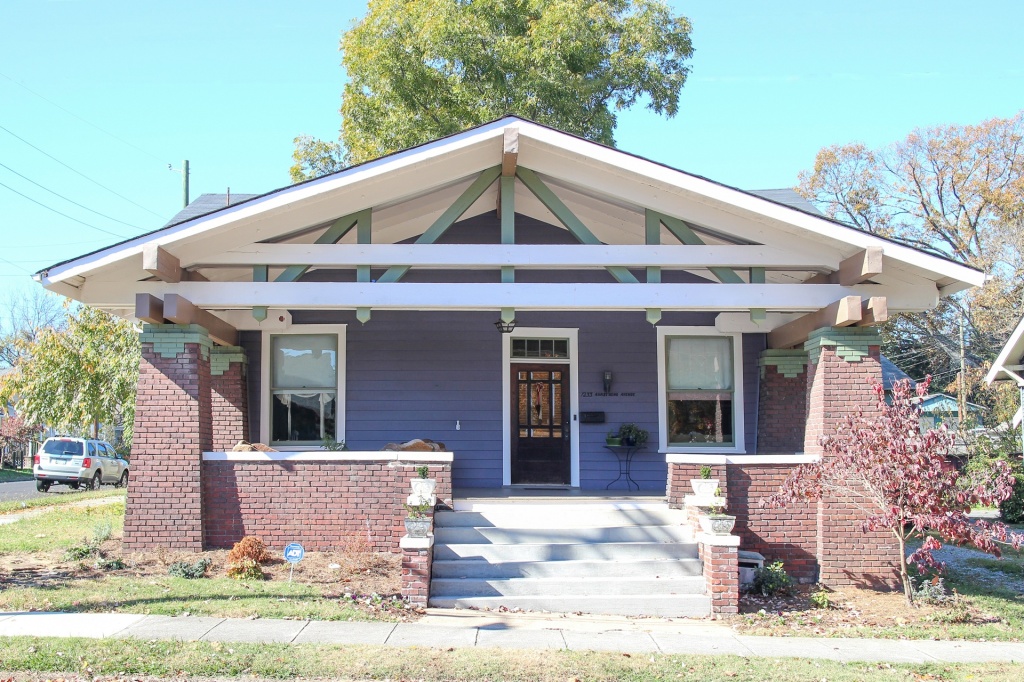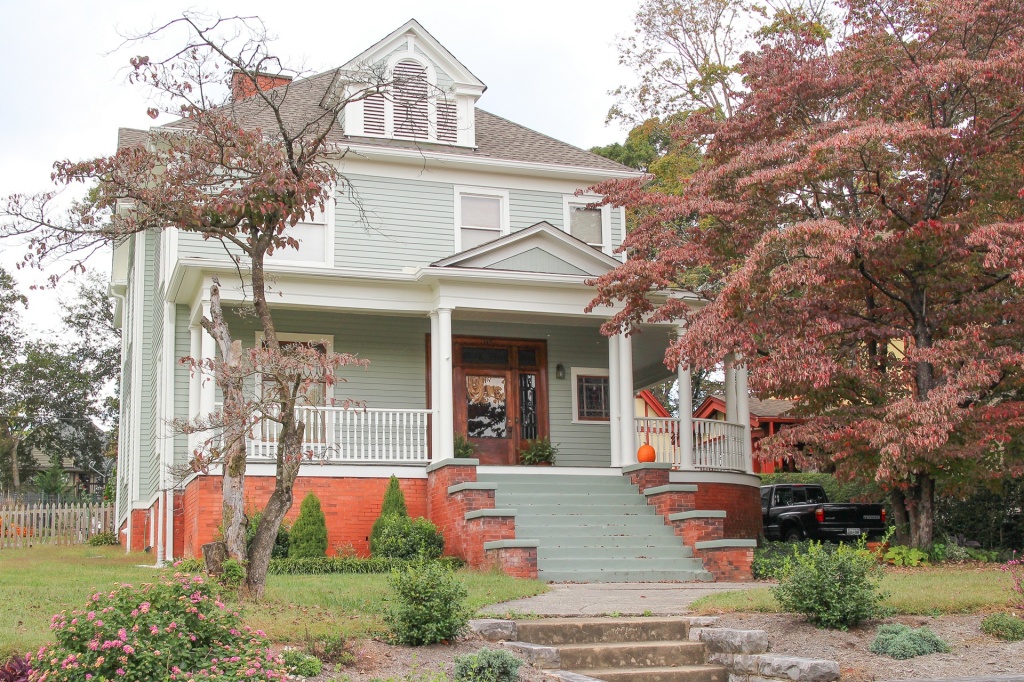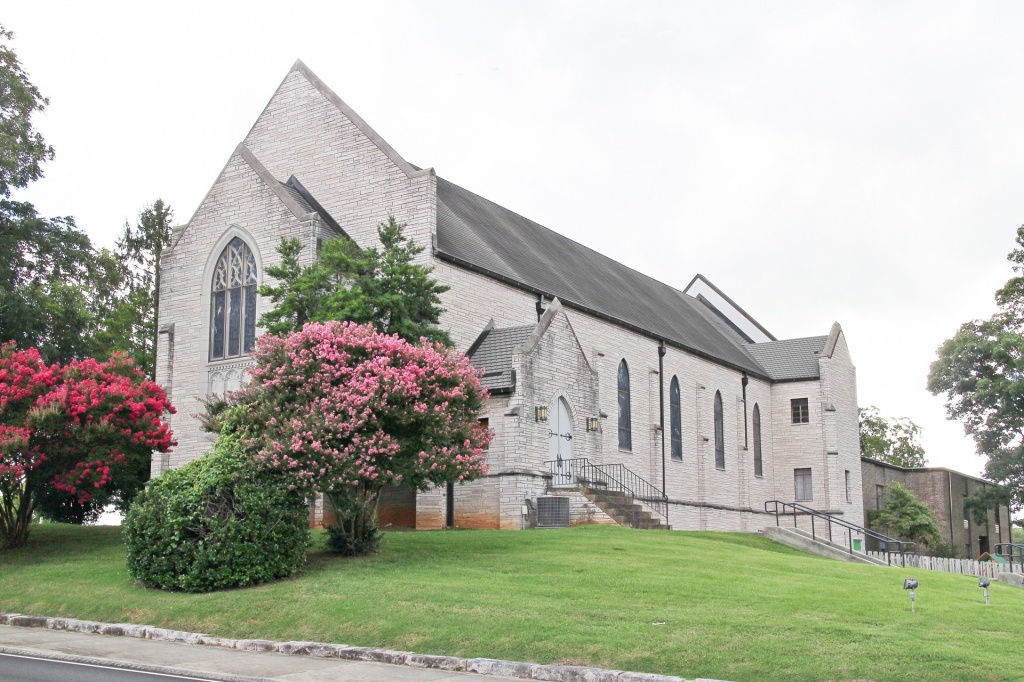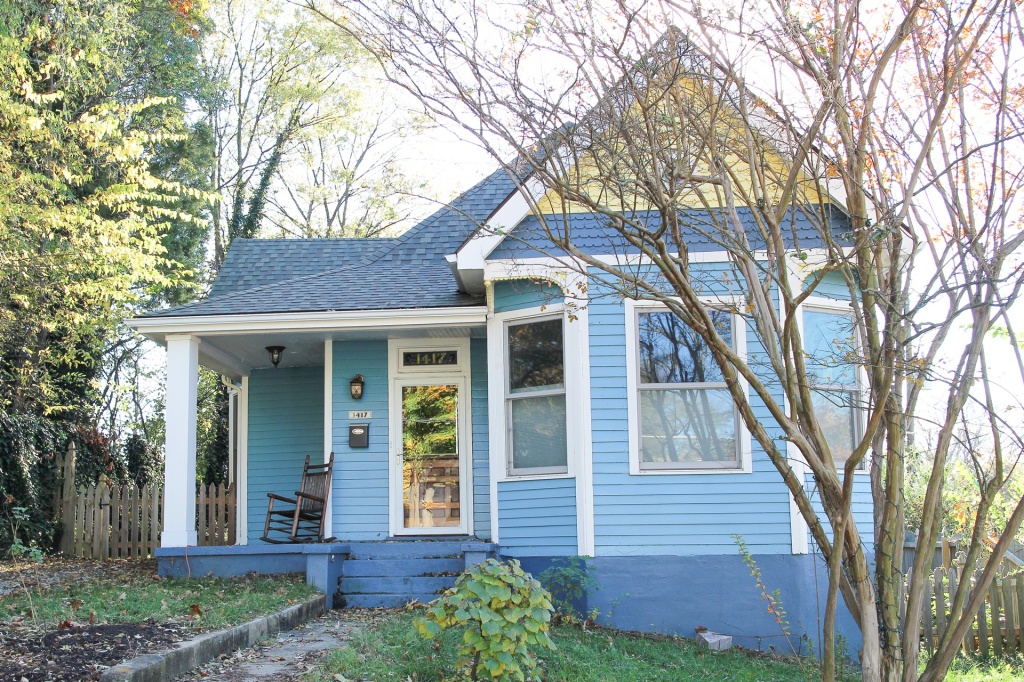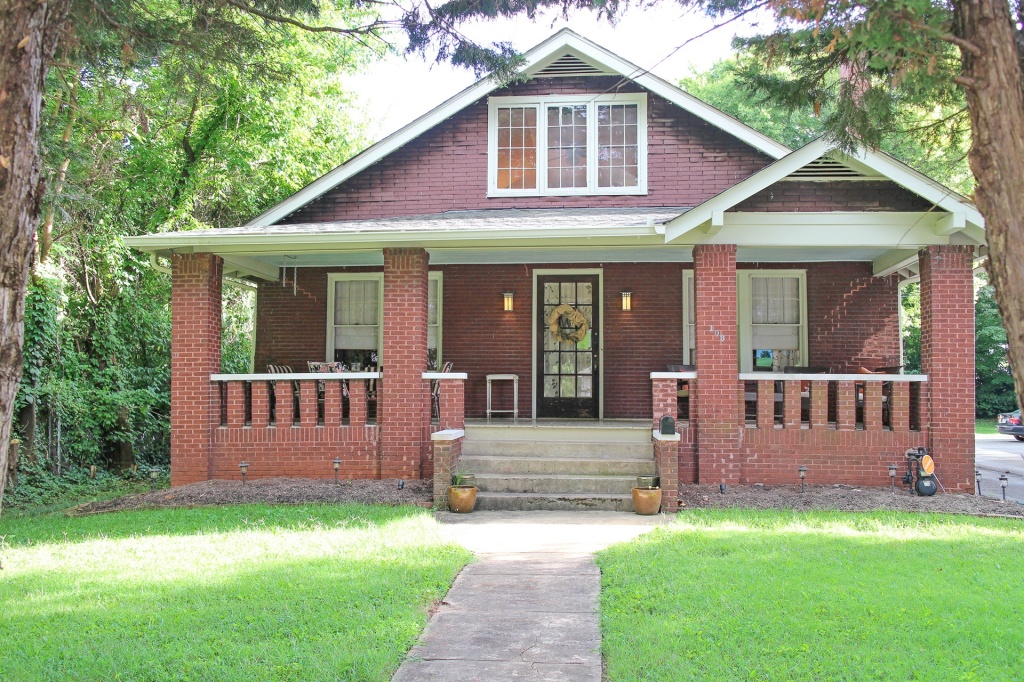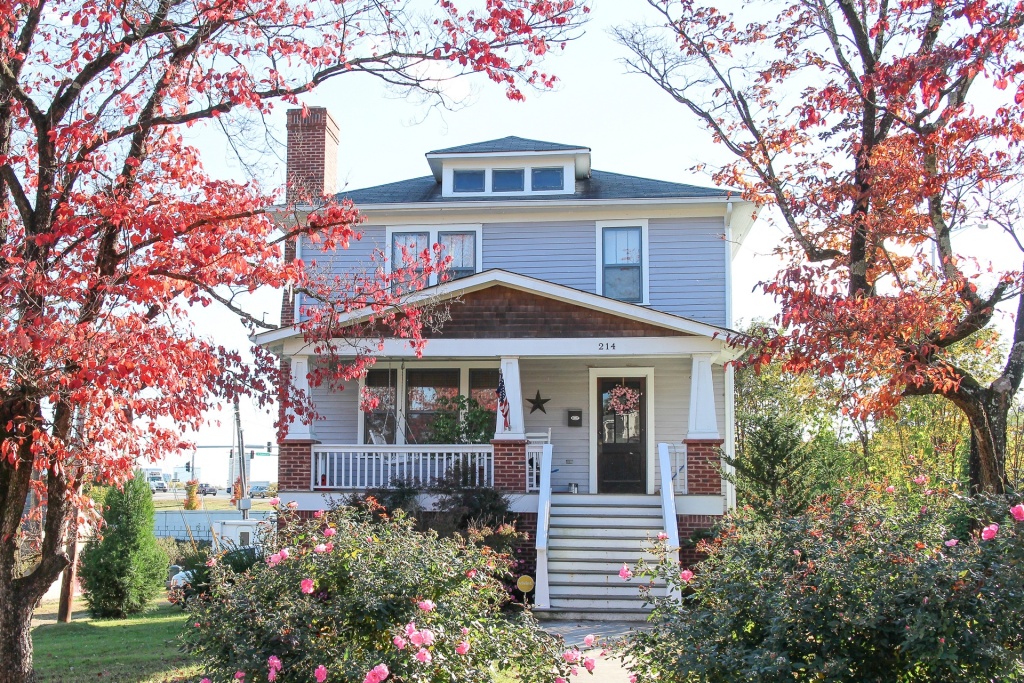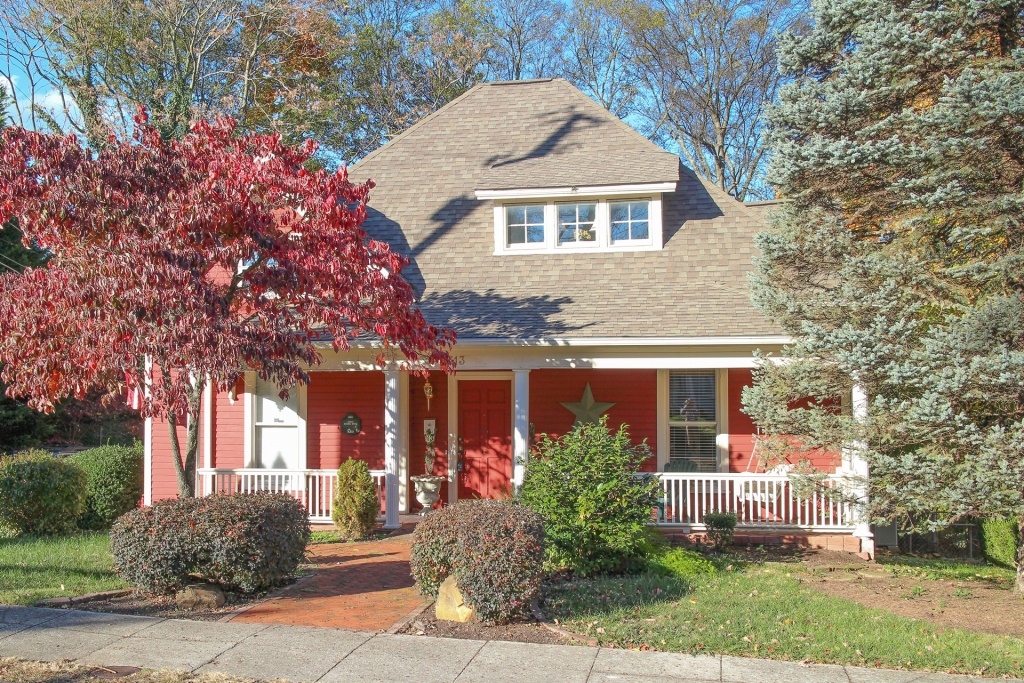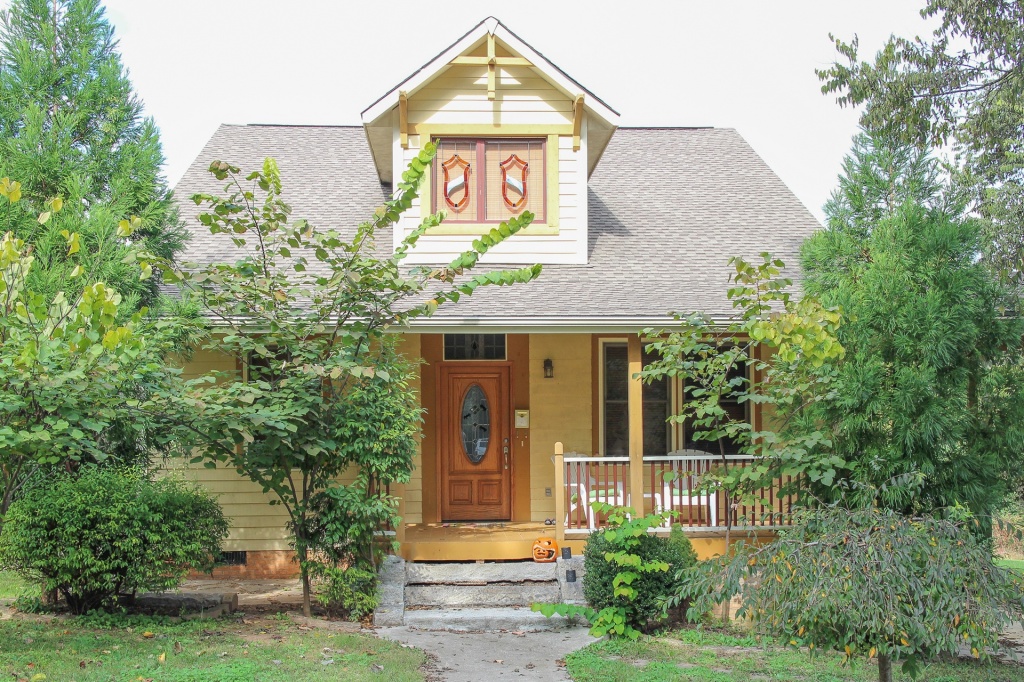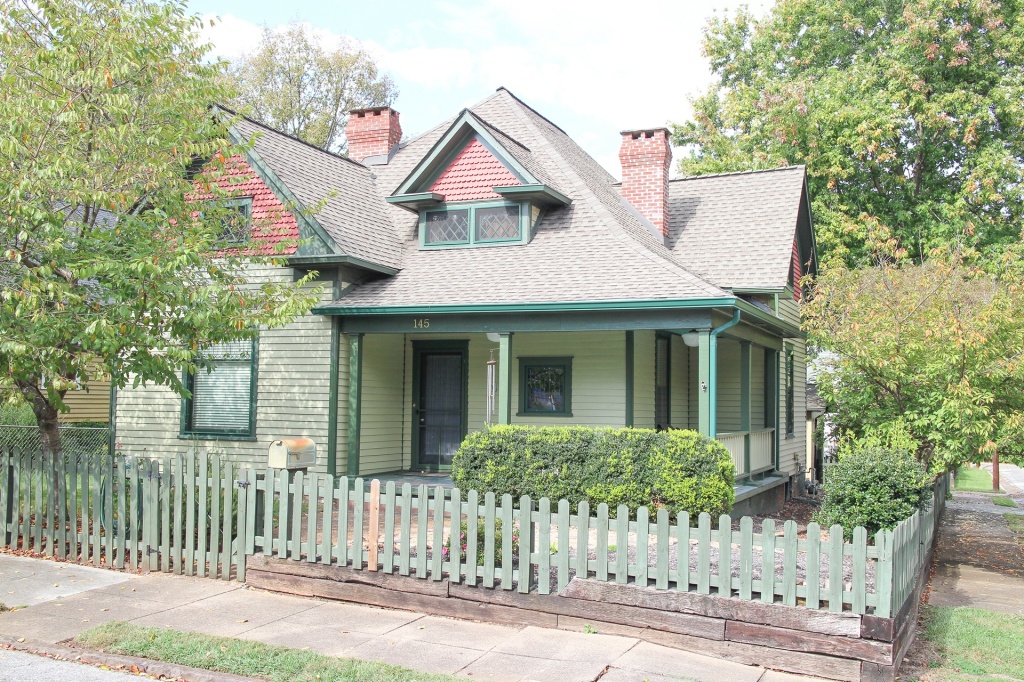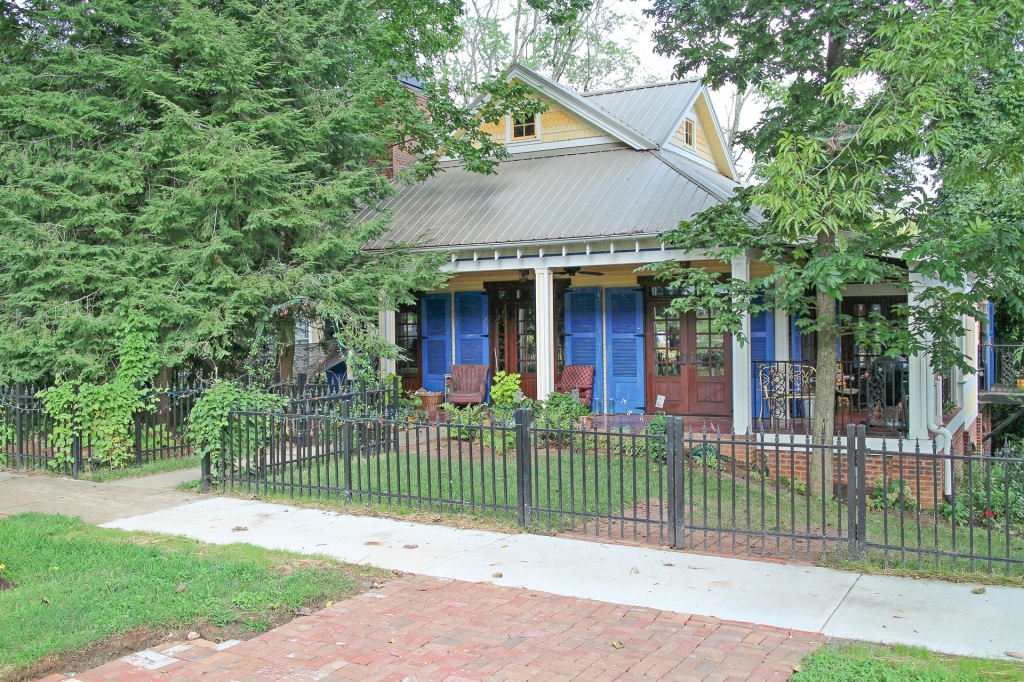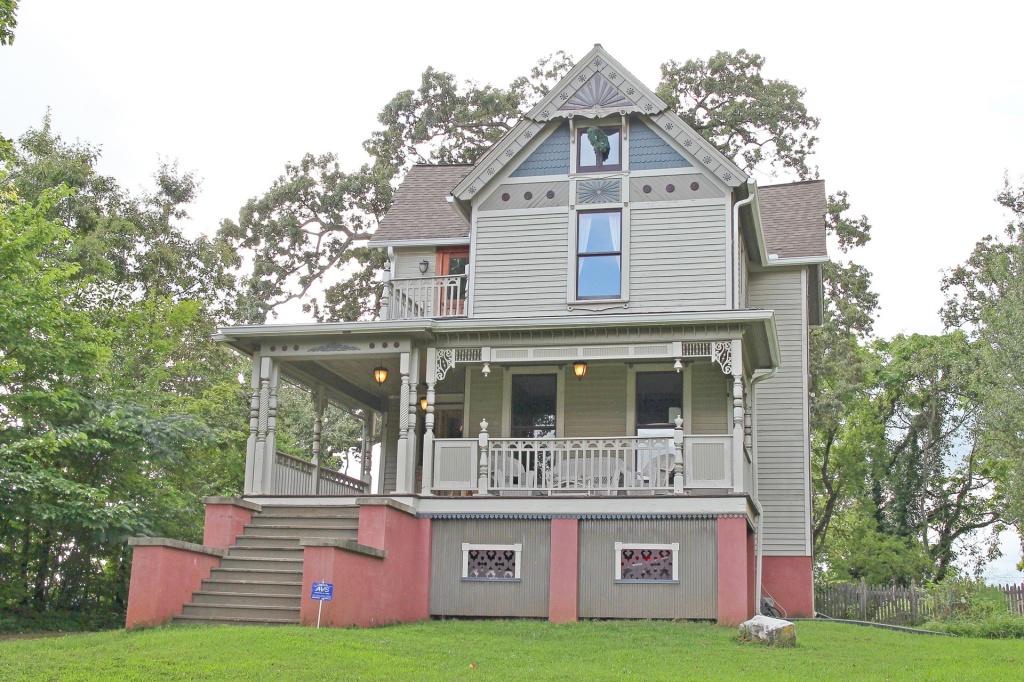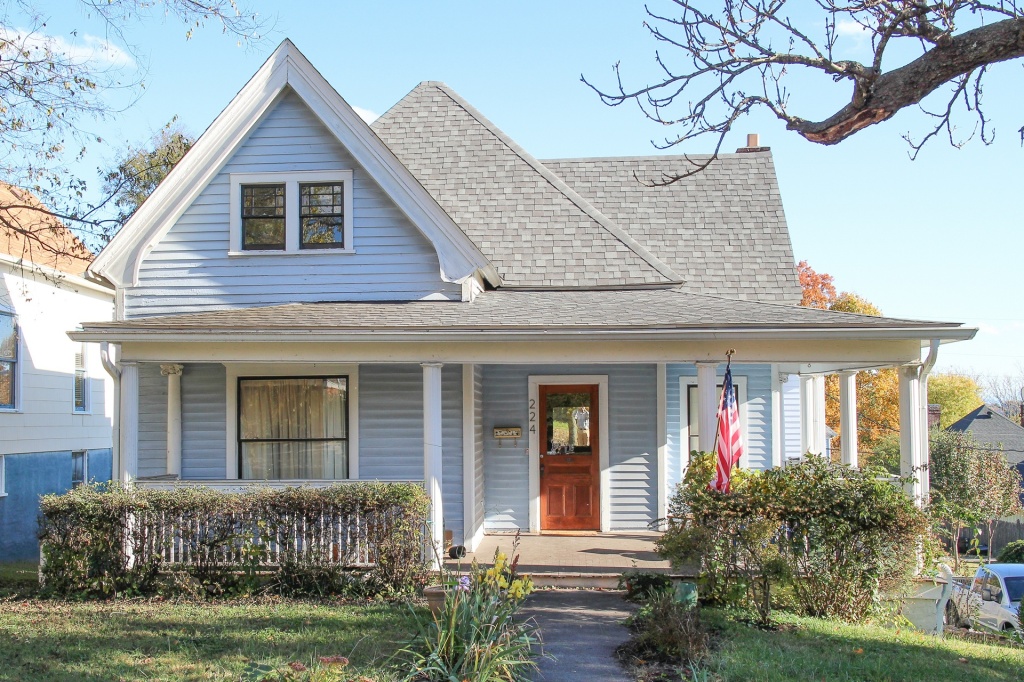1233 Armstrong Ave. Paull House, 1915
The Craftsman style of architecture evolved as a reaction to the elaborate shapes and complexities of Victorian design, as an offshoot of an emerging Arts & Crafts sensibility. Fanciful turrets and improbable overhangs were replaced by an honesty of structure. The porch of this house is an excellent example of the new ideal, with its heavy sawn wood beams, king post, and braces sitting solidly on substantial brick corner piers with cross-braced capitals. The brick balustrade and foundation also lend solidity to the weatherboard wall covering.
1233 Armstrong was built in 1915 for Charles Henry and Flora Rowe Paull. The couple had met a few years earlier when she bought a piano at Godfrey Scheitlin Music store on Gay Street, where Charles was working.
Charles had entered into a partnership in 1903 with Flora’s brothers, W.T. and D.C. Rowe, to form Rowe Transfer & Storage Co. After her husband’s death, Flora assumed the position of Vice President.
Renovations over the years have been respectful of the home’s historic character. Original plaster walls remain throughout the house, as do the original hardwood floors. The mantel in the living room and the built-ins are original to the house.
1349 Armstrong Ave. Noel House, 1908
This two-story Neoclassical house illustrates well how tastes in architectural design were transitioning at the time it was built, from the more decorative, irregular Queen Anne style to simpler forms – the exuberant was giving way to the stately. Details typical of the Neoclassical style include the porch with its Tuscan columns and portico, and the Palladian louvered attic vent.
Mrs. Mary Pearl Noel bought this lot in 1907 for $3000 from John M. Ross. The house was completed for her and her husband William the following year. William H. Noel was secretary and manager of Knoxville Meat & Sugar Co. In 1926, the house was sold to Vera M. Biddle. Her husband Culan V. Biddle worked as a salesman of real estate, rents, loans, and insurance. In 1940, the couple rented rooms to Maude Ann Cole, a doctor of neuropathy.
In addition to the leaded glass transom and sidelights at the front door, be sure not to miss the leaded glass in the large window opening onto the front porch, a precursor to the more modern “picture” window.
First Lutheran School began in 1870 on the Hill at UT. It is now attached to the First Lutheran Church. A major renovation project was completed in 1979 with the addition of a new wing housing additional classrooms and a gymnasium and cafeteria.The school is now undergoing renovation throughout. The past two summers have been busy with a main entry hallway facelift with new carpet and paint. The summer of 2013 brought new carpet to the second floor and new a new paint job. New laptop computers have been installed in the computer lab and in the classrooms. Many faculty and staff members have also gotten updated computers and Smart Boards.Since hiring an Admissions and Marketing director last fall, the school has seen a 21% increase in enrollment for the 2013-2014 school year. Also, the church is entertaining the idea of a new school building in the future.
The Church has a long history in Knoxville being established in 1869.. The present building is designed in the Gothic style and was built on the site of the Francis House in 1955. One of its main attractions structurally is the Memorail Windows.
The organ also has a rich history. It was built by Rudolf von Beckerath of Hamburg, Germany arriving in June,1974 in New Orleans and in Knoxville July 2, 1974. It took 10 men from the church and 2 from Hamburg to get the crates into the church. It is noted for the Tracker Action, low wind pressures, and casework surrounding the pipes.
1417 Cornelia St. Fair-Hiscock Cottage, c. 1893
This Queen Anne cottage was built around 1893 at the rear of a lot purchased in 1890 by James Eugene and Agnes Fair, as part of an exchange for two lots at the present corner of Oklahoma and McMillan that had been previously purchased by Agnes – in Mountain View Addition, as the immediate neighborhood was named, the top of the ridge was a much more prestigious building location. This house’s first resident was Leonard L. Oliver, a carpenter, in 1894. The Fairs moved in in 1895 while their house, the large Victorian fronting on Scott Ave. was being completed. They soon sold the house to Joseph W. Hiscock, secretary of Fair Foundry Co., J.E.’s business on Oldham Ave. Hiscock sold the house in 1919 to Charles S. Reese, a foreman at Fair Foundry. The Fairs left their Victorian mansion and the neighborhood in the 1930s for a new (and smaller) house in Sequoyah Hills.
Agnes Fair, from around the age of 105, was featured every year in the local papers on her birthday. She died in 1968 at the age of 110, as the oldest person in the Southeast.
1417 Cornelia passed through many more owners, eventually becoming a decrepit duplex rental house. A fire in 2007 nearly doomed the house, leaving if charred and with holes in the roof, but it was bought by a group of neighbors in 2011, intent on saving it. Their rebuilding efforts included LEED and Energy Star certifications. One original chimney remains, but nothing else of the original interior survived the fire. The renovation process was chronicled on the DIYNetwork series “Uncondemned,” which aired Fall 2013.
108 E. Glenwood Ave. A.G. Heins House, 1924
Albert G. and Caroline Reynolds Heins bought the property this house stands on in 1922 from George M. Camp, son of Maj. Eldad Cicero Camp, whose mansion, Greystone, still stands behind it on Broadway. 108 E. Glenwood was completed in 1924.
Albert was president of A.G. Heins Co., a supplier of building materials. He had begun his career as a salesman for Philip Carey Manufacturing Co. before founding his own business in 1920. Now a fourth generation company, A.G. Heins still operates as a building supply house on Heins St. off Blackstock Ave. just northwest of downtown. Albert lived in this house into the 1980s.
Though the house might seem modest for the president of a prominent building supply company, it is, understandably, well built. Be sure to notice the quality of the original woodwork and built-in bookshelves beside the fireplace, and the original coal insert. The hardwood floors and the beautiful glass paned doors are original.Former Brownlow students tell of seeing Mrs. Heins playing the piano in the living room as they walked past the house.
The current owners have recently renovated and converted the upstairs space into a master suite.
214 E. Glenwood Ave. Shoemaker-Vance House, 1924
This Craftsman style house was built for Edgar Wallace Shoemaker, a crane operator in a Knoxville Marble quarry, and his wife Rena Henry Shoemaker at what would have been 1326 Eleanor St. In 1936, the house was purchased by Samuel Vance, a conductor for the Southern Railroad, and his wife Flora, who raised seven children there. Members of the Vance family occupied the house from 1936 until 2004, a period during which all of the house’s Eleanor St. neighbors were demolished for the construction of the interstate. Two blocks of Eleanor Street itself also disappeared, and the house found itself facing onto an interstate ramp.
In 2004, as part of the planned Hall of Fame Drive improvements, TDOT purchased the house for demolition. Ms. Iva Vance contacted Knox Heritage for help saving her family home. With the cooperation of TDOT, Knox Heritage purchased a vacant lot next door, and in May 2005 moved the house a few hundred feet and turned it to face Glenwood. The current owners Jesse and Martha Andrus have lived in the home since 2007. Despite the major change of its actual location, the layout of the house remains essentially unchanged, with the exception of closets upstairs. New plumbing, heat and air, and electrical systems have prepared this house, a survivor, for its next century.
1313 Grainger Ave. Peters and Bradley Mill / Kearns House, 1900
In 1900, this charming Queen Anne cottage was inhabited by Luther and Emily Kearns, their two daughters, Luther’s sister Cordia, Emily’s brother Joseph Harris, and the family cook, Elzie Phipps. Luther Kearns was the secretary of Peters & Bradley Mill Co., whose building once stood just beyond its backyard.
A hundred years ago, houses often held much more complicated family units that they generally do today – there was less expectation of private space, even in houses of this size, and vacant rooms were often rented to boarders as a source of additional income.
1313 Grainger remained a single family house, complicated though that family might be, through its entire history, and since it never endured being subdivided, it has retained its original mouldings, underpanels on the windows, and mantels. Early brass light fixtures still hang in the dining room and front bedroom. A modern deck off the kitchen is tastefully hidden from the street. Be sure to note the lovely original heart pine paneled staircase.
1329 Grainger Ave. Duncan House, 2005
This house was the second new house to be built in Old North Knoxville after the adoption of its Neighborhood Design Guidelines. The site itself, once the location of the oldest house on Grainger Ave., had been vacant since 1983 when it and the house on the neighboring lot were bulldozed by a developer in anticipation of building a 12-unit apartment building. This proved to be a galvanizing event in the preservation movement within Old North Knoxville. The Brownlow Community Organization fought through Metropolitan Planning Commission and City Council to stop the development, and to begin the process of adopting a protective H-1 zoning overlay. Several builders and developers spoke out, saying that if the design guidelines were adopted into law, there would never be another house built in the neighborhood – it would be too restrictive and too expensive. Essentially, a vote in favor of the design guidelines would be a vote to ruin the neighborhood. Yet, the community organization prevailed. So angry was the developer at not being allowed to wedge his apartment house into the neighborhood that he refused to sell the vacant lots to anyone else for the next twenty years.
Both this house and the one next door were completed in the mid 2000’s, with the neighborhood under historic zoning protections, following the design guidelines, and both made a profit for their developer.
145 Leonard Pl. Jones House, 1908
This part of Old North Knoxville, formerly known as the Brownlow Community, was laid out in the late 19th century as Moses Mayfield Addition in large double and triple sized lots, to lure people from the more crowded parts of the city nearer to downtown, for the construction of suburban estates. Finding little demand for this plan, the developers soon further subdivided the lots, and the neighborhood began to be populated by workers’ cottages.
Turn-of-the-twentieth-century Knoxville had plenty of unsafe and substandard housing, certainly, but this Queen Anne cottage illustrates perfectly that “worker’s cottage” was by no means synonymous with slum housing. Imbricated fishscale shingles on the second story, lattice pane windows, and a leaded glass transom over the large window on the front of the house all speak to a level of quality that might be expected only on larger houses.
The lot was purchased by Bertie Jones in 1906 and the house completed for her and her husband Edward, a clerk at the Miller Store, by 1908. Other members of the family were jewelers and watchmakers. The Joneses had only one son still at home by 1910, and finding themselves with a spare room, took in a boarder, Pearl Hawkins, a music teacher at the county high school.
The present owners have recently completed a renovation of their kitchen.
318 E. Oklahoma Ave. Ray-Hudson House, 2011
Although a house may have stood on this lot as early as 1908, by the time the lot was purchased by Andie Ray and Noel Hudson, it was only a distant memory.
Scattered through Knoxville’s historic neighborhoods are “infill” houses, built, like this one, on vacant land, taking advantage of existing infrastructure, mature street trees, neighborhoods with sidewalks and small parks, and proximity to the center of the city – as Andie put it, “within walking distance to Market Square.” Old North Knoxville has a zoning overlay requiring that construction of this sort conforms to district design guidelines – new construction must be differentiable from its historic neighbors, but it also must be compatible.
The Ray-Hudson House is a beautiful example of this. Conceived of by Noel on a cocktail napkin, with the goal of being energy efficient but with an old look, the couple benefitted from the vision of local designer Christopher King to flesh out the design, meshing the couple’s antiques and artwork with the necessities of modern living.
The house earned a design award from Knox Heritage in 2013 for Compatible Infill.
Margaret F. Stuart House, 1889
On March 19, 1874, Jacob S. Stuart died of typhoid pneumonia, leaving a wife and seven children. This might have been the beginning of a tale of disaster and woe, but Margaret Stuart was hardly left destitute. Jacob Stuart was a grandson of Governor Thompson of New Jersey. Margaret was a daughter of General Alexander Anderson and a great-granddaughter of Alexander Outlaw, one of the pioneers of the state of Tennessee. She was a beneficiary of vast landholdings of the Anderson family, and in booming post- Civil War Knoxville, land was wealth.
Curiously, for all her property, Margaret Stuart built this house in 1889 on a 50 by 150 foot lot that she had purchased from the eponymous J.F. Scott. It was one of the first four houses on Scott Ave.; yet, the house is a relative newcomer to Old North Knoxville. Isolated, mistreated, and threatened with demolition, Margaret Stuart’s house was rescued by its current owner, by extraordinary means. In June 2006, the Stuart House made the rare journey across Central St. from its original location at 118 W. Scott Ave., and settled into Old North Knoxville proper.
Very little of the house’s interior, with the exception of the original heart pine staircase, was still intact. It had been gutted, its original windows removed, and no trace of the porch remained. Its owner has been diligently restoring the house since that time. One large oak tree that had to be removed to facilitate the house move has been milled on site to create the trimwork.
There had been a house on this lot in the past, built by William H.H. Clements in 1893, but it had burned. When Margaret Stuart died in 1903, W.H.H. Clements was one of her pallbearers. It’s an odd bit of symmetry that Clements carried Margaret Stuart in death, but that the site of his lost house provided a location for a second life for hers.
Charles DePue House, 1898
Several members of the DePue family immigrated to Knoxville from New Jersey during the last decades of the nineteenth century, lured by business opportunities and existing family connections. The first was Zilpha DePue, who had married James Baker Hoxsie, a Union Major from Rhode Island who had fought at the Battle of Fort Sanders. After the War, he became superintendent of the East Tennessee & Virginia Railway, director of the East Tennessee Coal Co., manager of the Crystal Ice. Co., and owner of Knoxville Steam Laundry. Zilpha’s brother Charles Wesley DePue had fought in the New Jersey Infantry during the War, and afterwards settled in Knoxville, running a company that dealt in stoves and tinware, eventually transitioning to the manufacture of oil tanks. Critical health issues interfered, and in 1890 he filed as an invalid with the Civil War Pension Board. The lot on which this house was constructed was given to Charles W. DePue and his wife and children in March 1897 by his sister Zilpha, “in consideration of the love and affection for her near relatives.” Charles died in 1903. Other DePue relatives occupied the house for a few years until they defaulted on the mortgage in 1908. Zilpha DePue Hoxsie died after jumping from a second story window of her Luttrell St. home in 1911.
The large front window, decorative attic windows, and substantial bargeboard are common to the Queen Anne style of this cottage.

